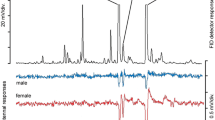Summary.
Aphidophagous ladybirds are reluctant to oviposit in patches of prey where conspecific larvae are present. This is adaptive as larval cannibalism is a major threat to egg survival. Ladybirds avoid laying eggs in such patches by responding to a species specific oviposition deterring pheromone present in the tracks of larvae. This study revealed that the oviposition deterring pheromone consists of a mixture of alkanes of which n-pentacosane is the major component (15.1%). These alkanes are likely to spread easily on the hydrophobic cuticle of plants and so leave a large signal. In addition, they are not quickly oxidized and therefore provide a long lasting signal. The latter was confirmed by the observation that 10 day old tracks still deterred oviposition.
Similar content being viewed by others
Author information
Authors and Affiliations
Additional information
Received 22 May 2000; accepted 28 November 2000
Rights and permissions
About this article
Cite this article
Hemptinne, JL., Lognay, G., Doumbia, M. et al. Chemical nature and persistence of the oviposition deterring pheromone in the tracks of the larvae of the two spot ladybird, Adalia bipunctata (Coleoptera: Coccinellidae). Chemoecology 11, 43–47 (2001). https://doi.org/10.1007/PL00001831
Issue Date:
DOI: https://doi.org/10.1007/PL00001831




